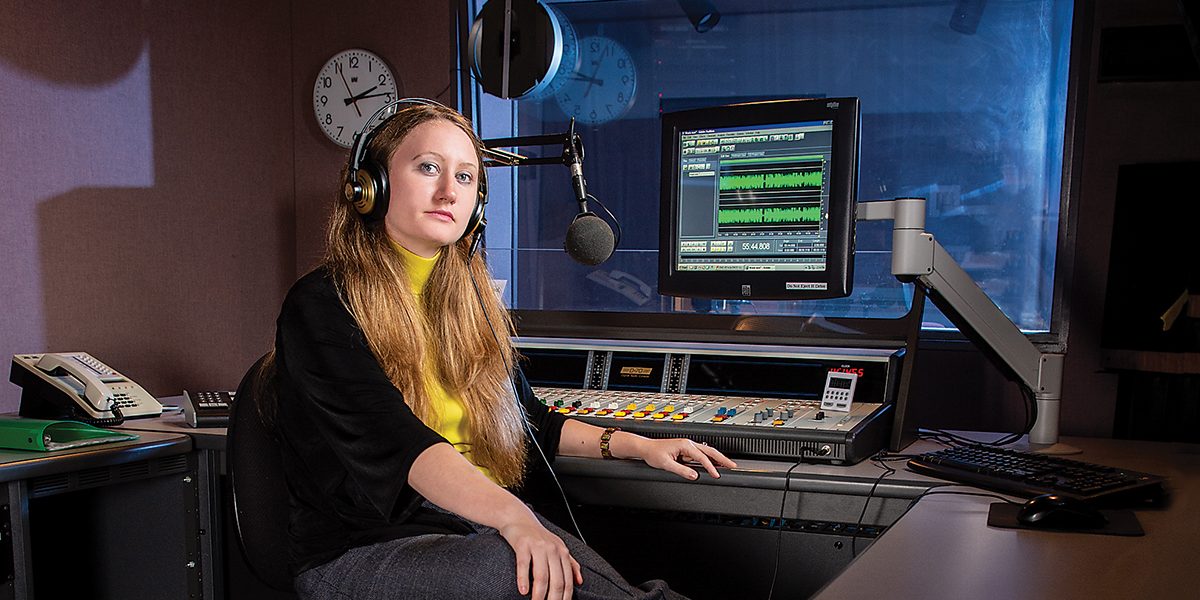Arts & Culture
Cameo: Katie Marquette
We talk with the host and producer of The Noir and Bizarre podcast.
How did you get started in radio?
Completely by accident. I had no intentions of doing anything in radio. I have a master’s degree in conflict resolution so I thought I was going to be studying religious conflict in the Middle East. I started working as a content producer for an independent radio show called Interfaith Voices that’s housed at WAMU in Washington, D.C.
As a content producer, I was advising on stories and writing scripts. It was a very small staff so everybody pitched in and did a little it of everything. They taught me about the audio side of things and I learned that I liked that equally as much as I liked storytelling.
What drew you toward the audio side of storytelling?
For me, it was a new platform for creativity. I love mixing interesting sounds and the fact that you can tell a story in a unique way through audio. Plus, it’s a really intimate medium. Listeners are most likely listening [to podcasts] while they’re driving or at the gym. Either way, you’re alone with one person’s voice in your ear. It’s a new medium, but it’s also an old-school way of storytelling.
WYPR’s podcast The Noir and Bizarre explores strange local stories with an emphasis on Baltimore’s spooky history. Where did this idea come from?
Last fall, we had an internal podcast committee to look at ways that we could develop in-house podcasts. All of the producers had a chance to pitch ideas, and I was really interested in doing something that would bring out the quirkiness of Baltimore. I wanted to play with historic topics that would tell new, interesting stories and give listeners a real sense of place. Baltimore is a weird city—we all know a strange local story—and I wanted to bring those out for everyone to hear.
How does the podcast discuss familiar topics, such as the life of Edgar Allen Poe, in a new way?
I find that, while people might be familiar with the general idea of an aspect of Baltimore’s history, they may not know all of the details. I’m not just interested in telling people facts, but exploring bigger questions, such as why are we still reading [Poe]? Why does his work continue to resonate with people after so many years?
Tell us how you approach storytelling in the podcast.
I try to walk a line between being serious and being campy. . . .I don’t want to freak people out, and I’m not into horror, but I do like weird, off-the-beaten-path stories. I like adding a dose or suspense or an eerie vibe to an episode, but I’m not here to scare anybody. A lot of the creepy things that we’re interested in surround bigger questions that are really important. I think people respond well to it because it’s a safe way to play with ideas like death and mortality.
What do you want listeners to take away from the podcast?
I want people to appreciate the city and its history, even the weird parts. And I hope it encourages people to go places like The Walters Art Museum, The Baltimore Museum of Art, and the Peabody Library—these historical resources are right here, and they’re amazing. These spaces have so much history. Every piece of art in the museums and every book in the library was put there for a reason, and there’s a story behind each one.
Going forward, what do you think the distinction between regular programming and podcasts will look like for local radio stations?
One big difference is that podcasting is on-demand. One of the beauties of radio is that, when you turn on the dial, you don’t know what’s on and there’s a serendipitous nature to it. But for podcasts, you have to seek it out on your own. You inherently have a more motivated listener because they have to find it themselves. I think that since there are so many podcasts nowadays, if radio stations can tie [their shows] to something local and tangible, it will be more appealing to listeners.
What do you see for the future of The Noir and Bizarre?
This podcast was an experiment and I’m glad it’s going well—I think it gets better with each episode. I don’t think we’ll run out of creepy or interesting things in Baltimore to cover, and I hope I can keep exploring them for as long as possible.
